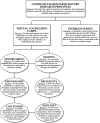Co-creating inclusive spaces and places: Towards an intergenerational and age-friendly living ecosystem
- PMID: 36685002
- PMCID: PMC9846501
- DOI: 10.3389/fpubh.2022.996520
Co-creating inclusive spaces and places: Towards an intergenerational and age-friendly living ecosystem
Abstract
Introduction: Evolving aging societies, ongoing digitalisation and circumstances of COVID-19 are changing living conditions for growing older. There is an increased urgency to view public health with a focus on integrating people of all ages into the matrix of opportunities afforded in their communities. This study initiates the conceptualization of an intergenerational, age-friendly living ecosystem (AFLE) to enhance public health planning.
Methodology: A participatory study was conducted using a multi-methods approach. Six virtual co-creation sessions (n = 35-50 participants), alongside a mainly open-ended INTERGEN survey designed specifically for this study (n = 130) were conducted to conceptualize multilevel ideas for building intergenerational age-friendly places using Bronfenbrenner's ecological systems model. At the height of COVID-19, virtual applications (Zoom, Moodboard) and case studies, creative methods (drawing, photography, storytelling and spotlight sessions) were applied to engage academic and non-academic participants between ages 5 - 80+ years, across eight countries. Sessions were video-recorded with visual themes captured by a graphic facilitator. The survey covered issues of multigenerational interactions; intergenerational and age-friendly place features; place safety; and necessary stakeholders required for creating intergenerational and age-friendly places. Data were reflexively analyzed using a team approach to thematic analysis.
Results: Findings present both the thematic analysis of Virtual Co-creation Camps (VCCs) and the INTERGEN survey results. These findings are addressed in three overarching categories that highlight the necessary characteristics of AFLEs as suggested by the VCC participants and survey respondents: (i) Sensory factors: feeling and emotion as starting points for physical design; (ii) Physical and digital factors in designing AFLE spaces and places; and (iii) Socio-cultural factors: tackling ageism and exclusion as part of the solution.
Discussion: The analysis resulted in a pathway toward enhanced understandings on how multi-generations can better interact with fluctuating organizational domains (industry, voluntary, academic and public sectors) in urban and rural settings to facilitate intergenerational connectivity. Through processes of co-creation, an AFLE proof of concept and roadmap for public health planning was developed to support and provide opportunities for people as they age to reap the socioeconomic benefits of their local and virtual communities and help them become well integrated, valued and contributory members of society.
Keywords: age-friendly cities and communities; co-creation; creative methods; ecological theory; lifespan; sustainable development; transdisciplinary working.
Copyright © 2023 Fang, Sixsmith, Hamilton-Pryde, Rogowsky, Scrutton, Pengelly, Woolrych and Creaney.
Conflict of interest statement
The authors declare that the research was conducted in the absence of any commercial or financial relationships that could be construed as a potential conflict of interest.
Figures


Similar articles
-
Feeling Valued and Adding Value: A Participatory Action Research Project on Co-creating Practices of Social Inclusion in Kindergartens and Communities.Front Public Health. 2021 Apr 26;9:604796. doi: 10.3389/fpubh.2021.604796. eCollection 2021. Front Public Health. 2021. PMID: 33981658 Free PMC article.
-
Active and healthy ageing in urban environments: laying the groundwork for solution-building through citizen science.Health Promot Int. 2022 Aug 1;37(4):daac126. doi: 10.1093/heapro/daac126. Health Promot Int. 2022. PMID: 36102480 Free PMC article.
-
Cross-National Perspectives on Aging and Place: Implications for Age-Friendly Cities and Communities.Gerontologist. 2022 Jan 14;62(1):119-129. doi: 10.1093/geront/gnab170. Gerontologist. 2022. PMID: 34791252
-
Age-Friendly Communities Initiative: Public Health Approach to Promoting Successful Aging.Am J Geriatr Psychiatry. 2016 Dec;24(12):1158-1170. doi: 10.1016/j.jagp.2016.07.021. Epub 2016 Jul 28. Am J Geriatr Psychiatry. 2016. PMID: 27742528 Review.
-
The Role of Mobility Digital Ecosystems for Age-Friendly Urban Public Transport: A Narrative Literature Review.Int J Environ Res Public Health. 2020 Oct 14;17(20):7465. doi: 10.3390/ijerph17207465. Int J Environ Res Public Health. 2020. PMID: 33066528 Free PMC article. Review.
Cited by
-
Enhancing Community Participation through Age-Friendly Ecosystems: A Rapid Realist Review.Geriatrics (Basel). 2023 May 11;8(3):52. doi: 10.3390/geriatrics8030052. Geriatrics (Basel). 2023. PMID: 37218832 Free PMC article. Review.
-
Rural age-friendly ecosystems for older adults: An international scoping review with recommendations to support age-friendly communities.Health Sci Rep. 2023 May 5;6(5):e1241. doi: 10.1002/hsr2.1241. eCollection 2023 May. Health Sci Rep. 2023. PMID: 37152222 Free PMC article.
-
Multidimensional Evaluation of the Process of Constructing Age-Friendly Communities Among Different Aged Community Residents in Beijing, China: Cross-Sectional Questionnaire Study.JMIR Public Health Surveill. 2025 Mar 21;11:e66248. doi: 10.2196/66248. JMIR Public Health Surveill. 2025. PMID: 40116739 Free PMC article.
-
Hearing Loss and Social Isolation in Community-Dwelling Older Adults: The Role of Neighborhood Disorder and Perceived Social Cohesion.Int J Environ Res Public Health. 2025 Apr 8;22(4):583. doi: 10.3390/ijerph22040583. Int J Environ Res Public Health. 2025. PMID: 40283807 Free PMC article.
References
-
- United Nations. World Population Ageing 2017—Highlights. New York: United Nations, Department of Economic and Social Affairs, Population Division; (2017).
-
- World Health Organization . Towards an Age-friendly World. (2019). Available online at: https://www.who.int/ageing/age-friendly-world/en/ (accessed January 16, 2020).
-
- World Health Organization . World Report on Ageing and Health. Geneva: World Health Organization; (2015).
-
- World Health Organization . Global Age-Friendly Cities Project. (2019). Available online at: https://www.who.int/ageing/projects/age_friendly_cities/en/ (accessed January 16, 2020).
Publication types
MeSH terms
LinkOut - more resources
Full Text Sources
Medical

